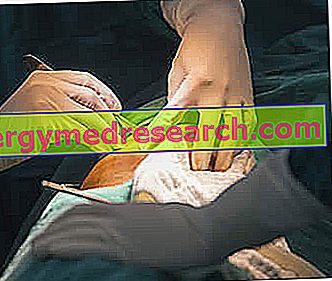Generality
The istmocele is a cicatricial pathology that results after a cesarean section .

More precisely, it is a saccular formation, similar to a hernia or a diverticulum, which develops in the wall of the uterus, starting from the surgical wound that results from the incision made to facilitate the birth of a child .
The istmocele can cause various disorders, such as pelvic pain and atypical post-menstrual blood loss, up to infertility or difficulty in undertaking another pregnancy.
In symptomatic cases, it is possible to intervene with drug therapy or surgery.
What's this
The istmocele is one of the complications that can occur after cesarean section .
In detail, it is a saccular diverticulum or a hernia that develops in the area between the cervical canal and the isthmus, also known as the internal uterine orifice (ie in the incision site used to extract the child, then sutured to end of the birth).
Isthmocele: appearance and characteristics
- The isthmocele appears as a recess or an interruption of the plication of the internal uterine orifice. This defect takes the form of a pouch or pocket lined with a smooth, thin and translucent mucosa. The istmocele is richly vascularized by the underlying tissue.
- Inside the istmocele, cervical mucus and menstrual blood can accumulate.
Important note
There is still no univocal and shared definition to describe the isthmocele. In fact, many terms have been adopted for this pathology such as hernia, diverticulum, sac, wedge, thinning, defect of the caesarean section scar etc. Added to this is a lack of consensus for the diagnostic criteria identified so far. In any case, despite being an "emerging" pathology, isthmocele is not a complication to be underestimated.
Causes
The istmocele is an alteration of the lining of the uterine walls, similar to a hernia or a diverticulum.
The pathology occurs more commonly in the anterior uterine isthmus or cervical canal, in correspondence with the suture line implemented after a cesarean section . The isthmocele can be interpreted, therefore as a defect of scarring.
The etiopathogenesis of istmocele is currently unknown, but several factors have been identified that can contribute to this complication.
Isthmocele: when does it occur?
The istmocele presents itself with greater possibilities in women who have had one or more caesarean sections: at the point where the incision was made, a loss or thinning of the endometrium occurs. However, in the onset of this pathology connections with other types of interventions, such as curettage, cannot be excluded.
Cesarean section: key points
- Cesarean delivery is an intervention carried out to facilitate the birth of a child. The doctor makes a surgical incision in the wall of both the abdomen and the uterus of the expectant mother, then extracts the fetus from the maternal womb. This option is chosen only when it is considered safer for the future mother or child, compared to the natural birth through the vagina.
- The operation is performed after the administration of anesthesia which may be spinal, epidural or general. The cesarean section extends about 8-15 cm, in a longitudinal direction (that is, in correspondence with the central line of the abdomen, starting from the pelvis) or transversal (above the pubis).
- The caesarean section can be elective (ie programmed at the end of gestation, before labor) or adopted in an emergency regime (when the health of the mother and child are in immediate danger).
- After a few weeks, the wound resulting from the surgical incision regresses naturally. Over time, if managed with due care, the caesarean scar becomes a thin, almost imperceptible sign. Other times, what remains of the cut can evolve into a keloid or give rise to other problems, such as hernias or adhesions, which make its presence particularly annoying.
Isthmocele: risk factors
The factors that can favor the onset of the disease are different and include:
- Material and technique of uterine suturing (eg suture in single / double layer, threads with slow resorption, ischemic suture, etc.);
- Previous cesarean section / number of cesarean sections;
- Discrepancy between the upper and lower margins of the hysterotomic incision;
- Abnormal suture reabsorption;
- Poor contractility of the uterine muscle around the scar of the cesarean section;
- Retroversoflexion of the uterus;
- Operative complications during cesarean section;
- Inflammation and / or infection of the caesarean section scar;
- Obesity or overweight;
- Maternal age less than 30 years;
- Duration of labor greater than 5 hours and cervical dilatation greater than 5 cm before cesarean delivery;
- Use of oxytocin.
Isthmocele: how frequent is it?
Indicatively, the isthmocele is formed in about 25-30% of women (1: 4) who gave birth by cesarean section.
Isthmocele: headquarters
The location of the istmocele appears to be correlated with the moment in which the caesarean section was performed, in relation to labor;
- In the case of elective caesarean section (outside of labor), it is interesting to note that the isthmocele generally has a high localization, ie cervico-isthmica .
- In women undergoing an emergency cesarean section (when labor began), instead, the site of the isthmocele is cervical, therefore medium-lower ; in this case, the location of the defect is more or less low, based on the degree of dilatation achieved by the cervix .
Symptoms and Complications
In some cases, the isthmocele is asymptomatic, so it is accidentally detected during post-partum examinations, such as a gynecological examination or a transvaginal ultrasound.
In most cases, however, the presence of the disorder is indicated by:
- Abundant menstrual flows (hypermenorrhea);
- Dysmenorrhea ;
- Pelvic pain (especially with supra-pubic localization);
- Pain during sexual intercourse .

During menstruation, blood can accumulate inside the isthmocele. This involves a relaxation of the saccular formation, with the possibility of abnormal uterine bleeding in the post-menstrual period (PAUB) . In this case, the blood loss is smelly and dark red-blackish. The menstrual blood that settles and remains in the isthmocele also helps to cause inflammation .
The possible consequences of the isthmocele include:
- Secondary sterility (the reduced ability to conceive depends on various factors, such as the chronic inflammatory state, the difficulty of the spermatozoa to pass through the cervix or the modifications of the mucus due to the retention of the menstrual blood);
- Ectopic pregnancy on the caesarean scar ;
- Abnormal placentations (placenta previa or accreta);
- Scar dehiscence (rupture of the uterus).
The presence of isthmocele predisposes to other diseases, including:
- adenomyosis;
- Endometriosis;
- Abscess formation.
The isthmocele also increases the risk of complications, if the patient is subjected to various gynecological procedures (eg IUD positioning, operations, use of uterotonics, etc.).
Diagnosis
The istmocele is usually identified during a transvaginal ultrasound or hysteroscopy. Other useful exams for disease definition and treatment planning can be contrast hysterosalpingography and magnetic resonance imaging.
Transvaginal ultrasound
Transvaginal ultrasound is the diagnostic technique with which istmocele is most commonly found. In correspondence to the scar of the cesarean section, it is possible to detect protrusions of the uterine wall (inward or outward) or of blood collections. In some cases, the isthmocele is described as a triangular area or a mass between the bladder and the lower uterine segment.
Hysteroscopy
Another diagnostic tool used for the evaluation of istmocele is hysteroscopy. This survey not only allows to verify the presence of the scar defect in cesarean section by direct observation, but also allows us to define its characteristics, such as the size and presence of concomitant phlogosis.
On hysteroscopy, the isthmocele appears as a bulging pocket, usually surrounded by a fibrotic ring.
Execution of the examination requires great care not to incur uterine perforation or damage to the bladder, especially if a short period of time has passed since the birth.
Treatment
The treatment of istmocele is indicated for symptomatic patients. The management of the disease involves both pharmacological measures and surgical interventions in order to limit or avoid any complications.
The choice of treatment is made based on the location of the isthmocele, the size of the sac and the disorders reported by the patient.
drugs
When the saccular formation is small, the therapy is pharmacological and is based on the administration of a estrogen-progestin pill . This combination of hormones regulates menstrual flow, thus helping to bring the thickness of the endometrium back to normal, solving the problem.
If after about six months, no improvements are found, however, it will be advisable to proceed by surgery.
Surgery
If the isthmocele reaches a considerable size, however, the indicated cure is surgical.
The options for the treatment of istmocele include:
- Operative hysteroscopy : resection of scar tissue surrounding the uterine wall defect;
- Laparoscopy : excision of fibrotic tissue and double-layered or detached margins;
- Procedure with vaginal access : incision of the scar and suture through the insertion of a small instrument through the vaginal canal;
- Combined approach : laparascopic-vaginal procedure.
When practicable, the first choice approach is generally hysteroscopic isthmoplasty, since it allows to obtain better results than the other techniques. This operation removes the edges of the bag and aligns them with the surrounding tissue, allowing the correction of scar formation in most cases (around 80%) and the complete resolution of the symptoms of this pathology.



